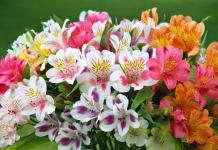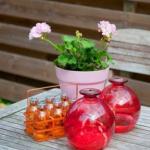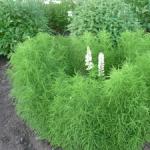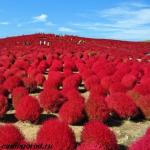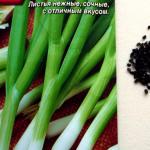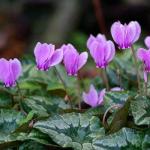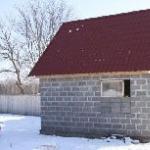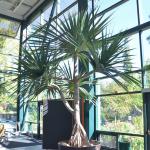Alstroemeria - Peruvian lily or lily of the Incas, originally from South America. This is a perennial plant, which is highly valued for the unusual beauty of the flowers, which retain their attractiveness in the cut for a very long time. That is why the cultivation of alstroemeria is widely used on an industrial scale - in the conditions of a greenhouse, a flower can be distilled twice a year.
Alstroemeria is a great opportunity to add exotic to your garden. It is quite high (in some varieties, flower stalks reach from 80 to 150 cm in height), the flowers are collected in racemose inflorescences - when Alstroemeria blooms, it seems that on flower bed a flock of exotic butterflies descended. Alstroemeria flowers are very reminiscent of lilies, only smaller - the largest reach a diameter of only 6 cm. The color of the flowers is the most diverse: pink, yellow, red, pale purple, almost always with spots on the petals. Another characteristic feature of alstroemeria petals is the longitudinal dark lines, which shorten and thin out closer to the center of the flower.
In the language of flowers, a bouquet of alstroemerias is a gentle but unobtrusive compliment - “You are so sweet” or “You are the most beautiful” with wishes of good luck, prosperity, wealth and friendship. Alstroemeria flowers are odorless, so they are perfect for people prone to allergies.
Alstroemeria in landscape design
Alstroemeria looks great as a tapeworm in group plantings and in flower beds, while undersized plants, such as tenacious or stonecrop, are selected as companions.
There are a large number of varieties and types of alstroemeria, but the following are best adapted to our conditions:
- Golden - a variety originally from Chile, shoots up to 90 cm in height, flowers - bright orange color. The variety is famous for the fact that its flowers are often used to create hair ornaments.
- Virginia is a variety with high, up to 70 cm, strong large shoots, on which large white flowers bloom. Flowering begins in June and can last until the first November frosts.
- Alicia is a beautiful two-tone flower, the petals are pink and white
- Lemon - a variety with a very large flower of a spectacular, bright lemon color, with a slight greenish tint
- Brazilian lily - very tall, shoots can be up to 2 m tall
Most often, preference is given to more familiar colors, the growing features of which are clear and simple. However, today in nature there are flowers that simply amaze the imagination with their beauty. But their cultivation causes some difficulties. These plants include alstroemeria - the flower of the Incas, which can so often be found in flower shops in bright and delicate bouquets. According to tradition, the rose is considered the most beautiful flower in the world - Alstroemeria is in no way inferior to its beauty. And with a little effort, you can grow this overseas miracle in your area.
In this article we will consider the features and description of alstroemeria, describe its main types and varieties. We will also highlight the nuances of agricultural technology for growing alstroemeria in the open field, at home and in a greenhouse.
Features and description of alstroemeria
Alstroemeria is a rhizomatous perennial herb that belongs to the Alstroemeria family and genus of the same name. In gardens in flower beds or flower beds, this plant is very rare, most often this delicate flower can be purchased at flower shops. The natural habitat of alstroemeria is the territory of South America, or rather countries such as Chile and Peru. It is in these countries that alstroemeria flowers can be found along roadsides, in wastelands, just like dandelions grow in our country.
This flower has been known since ancient times. In the ancient tribes of the Inca Indians, alstroemeria was revered as the flower of the gods. No wonder this plant was endowed with magical properties. Nowadays, alstroemeria is considered a symbol of good luck, prosperity, friendship and wealth.
When the territories of the Inca Indians began to be mastered by the Spaniards, the alstroemeria flower came to Europe, or rather to Spain. At first, few people paid attention to him. While traveling in Spain, Claes Alstroemer did not notice a small and delicate flower, which he had seen before. The scientist sent the discovered flower to Carl Linnaeus, who was involved in the systematization of plants. It was Linnaeus who attributed it to a separate family and named it after his friend the botanist, the zoologist Klas Alstremer.
In their appearance, alstroemeria flowers resemble lilies or daylilies, therefore, very often among the people, this plant is called the "Peruvian lily" or "lily of the Incas."
Description of Alstroemeria:
- Alstroemeria is only a perennial plant.
- The root system of the plant is represented by a rhizome, which has the shape of a spindle. It is highly branched and contains a large amount of starch.
- Alstroemeria is a herbaceous plant whose stems are very flexible and erect.
- Alstroemeria grows in height from 80 cm to 150 cm.
- This plant has two types of shoots: vegetative (the presence of large leaves collected at the top) and reproductive (leaves are small, evenly spaced along the stem).
- The leaves of this plant are quite unusual. During growth, they turn around the axis - in science this is called the term resupination. The degree of rotation of the leaves is approximately 180 degrees. On the flower, the leaves can be seen with the bottom plate up.
- The leaves have a bright green tint.
- Alstroemeria flowers are small, only 5 cm in diameter.
- In shape, they resemble lilies or, as this form is called in science, a zygomorph.
- All flowers are collected in large and rare umbrellas, which consist of 10-30 inflorescences.
- Alstroemeria blooms in late spring or early summer.
- The colors of alstroemeria are so diverse that you can easily choose your own shade. Most often they are red, yellow and pink. In some varieties, flowers may have dots or stripes.
- These plants are easily pollinated by insects.
- Most often, alstroemeria is grown commercially in greenhouses for sale, but you can decorate a garden or room with this plant.
- The fruit of the plant is a box with seeds, which, when ripe, scatter around the flower.

A variety of species and varieties of alstroemeria
To date, there are several dozen types of alstroemeria in the world, which differ in different stem heights, flower colors and growing characteristics. Breeders around the world have bred a large number of species varieties and hybrids. Since the alstroemeria flower is considered a heat-loving plant, scientists are trying to develop more resistant varieties to our climatic conditions. Consider the most common types and varieties of Peruvian lilies.
Golden Alstroemeria (Alstroemeria aurea)
- The natural habitat of this type of alstroemeria is the highlands of Chile.
- This is a fairly tall plant that can reach a height of 150 cm.
- Alstroemeria golden flowers have a different color: it varies from golden yellow to bright orange.
- The main feature of this type of Peruvian lily is its relative frost resistance. Alstroemeria golden endures frosts down to minus 12 degrees.
- Due to its hardiness, this type of plant is perfect for growing in our climatic conditions.

Alstroemeria brazilian:
- It is a Brazilian species of this flower.
- It can be attributed to tall plants that can grow up to 1.5 m in height. Some plants reach 2 m.
- A distinctive feature of this type of alstroemeria is the spear-shaped petal.
- The color of the flowers is red or bronze.
Alstroemeria nano:
- This plant is a Peruvian species.
- Alstroemeria nano is characterized by low growth, the stems reach a height of only 10 cm.
- The flowers have a bright golden hue with black spots.
- A small plant usually produces a large number of bright flowers.
Alstroemeria blood-flowered:
- The natural habitat of this species of alstroemeria is South America, namely the territory of Chile and Peru.
- Differs in fast growth.
- The root system is represented by a rather fleshy rhizome.
- Alstroemeria blood red is valued for its lush blooms. Approximately 15 flowers of a bright red hue appear on the plant at the same time.

Alstroemeria psittacina:
- The natural habitat is the territory of Argentina.
- The main value can be called flowers of unusual color. During flowering, the plant is covered with bright orange flowers with a green border around the edge of the petals.
Popular varieties and hybrids of Alstroemeria:
- Alstroemeria "Cosmo". This variety belongs to tall plants. It strikes with the beauty of snow-white flowers, which densely cover the entire plant.
- Variety "Alicia". Also quite a popular plant variety. Differs in two-color coloring of flowers. Alstroemeria "Alicia" blooms with white and pink flowers.
- Alstroemeria 'Virginia'. In height, this plant reaches an average of 80 cm. Feels great in light shading. Flowering begins in early June. This variety of Alstroemeria blooms with large white flowers with a wavy edge.
- Variety "Beauty". A tall plant variety, the average height is from 150 cm to 170 cm. Flowering begins in spring, and under favorable conditions it can bloom again. The flowers are lilac, less often - with a lilac tint.
- Alstroemeria "Harmony". A tall and powerful plant that can grow an average of 160 cm in height. It blooms twice a season: in April and September. Bronze-colored flowers with black strokes on the petals.
- Variety "Canaria". A powerful plant, the height of which reaches 1.5 m or more. It blooms twice a season: the first time in March. and the second - in the first half of autumn. As the name implies, the flowers have a bright canary shade with a subtle black speck.
- Variety "King Cardinal". Srednerosly plant with rather large flower stalks. Differs in long flowering, from the end of spring to the first frosts. It blooms with large red flowers similar in shape to orchids.
Reproduction of alstroemeria: the most common methods
Alstroemeria can be independently bred in your area. To do this, you need to decide on the method that suits you. This plant reproduces in two ways: by seeds and by dividing the rhizome. Both paths are distinguished by their peculiarities and difficulties, however, with due attention and effort, you will breed this amazing plant without any problems.
seed propagation
- Growing alstroemeria from seeds is possible for species varieties, as hybrid plants may lose their maternal traits.
- If you want to collect the seeds yourself, keep in mind that after ripening, the fruit cracks and the seeds scatter around the plant. To collect, you can wrap a faded bud with a piece of gauze so that the seeds fall exactly there.
- Alstroemeria seeds must be stratified before sowing. To do this, place them in a damp cloth and put in the refrigerator at a temperature of 2-5 degrees for 1 month.
- Seeds should be sown in late February or early March. In this case, you will receive seedlings for planting in open ground.
- After stratification, prepare containers with fertile soil, moisten it and place the seeds to a depth of no more than 1 cm.
- From above containers are covered with glass or film.
- For seed germination, the optimum temperature is 18 degrees.
- Seedlings appear within a month. After they have 3 leaves, be sure to dive the seedlings.
- Seedlings are planted in open ground in late spring.
- Alstroemeria planted from seeds will bloom only for 3 years.

Reproduction by division of the rhizome
- Using this method, hybrid varieties of alstroemeria are most often propagated.
- A planted plant with the help of division will bloom the next year.
- It is necessary to carry out the division of the rhizome after flowering. However, many gardeners do this in autumn, spring, and summer.
- Carefully dig up the alstroemeria bush. Make sure that the roots of the plant are not damaged.
- Experts recommend dividing the rhizome into a small number of parts, a maximum of 2-3 parts.
- Each part must have a sufficiently strong and powerful root system.
- The cut sites must be treated with a special disinfectant solution or charcoal.
- Alstroemeria seedlings should be planted immediately after division.
- Alstroemeria plants divided in this way will take quite a long time to take root, so they need constant care.

Stages of preparation before planting alstroemeria
Alstroemeria is an exotic plant, therefore it requires a serious attitude and attention. It is important to carefully prepare before landing. To do this, you need to choose healthy alstroemeria seedlings, choose a suitable place on the site, or find an ideal indoor pot for this plant. It is also important to properly prepare the soil.
Stage 1. Selection of varieties and seedlings of alstroemeria
- Alstroemeria is a heat-loving plant, it needs a warm climate with mild winters. However, there are varieties that can withstand light frosts with shelter.
- Currently, breeders have bred varieties for the middle lane.
- It is best to buy alstroemeria in specialized stores or agricultural firms that are professionally engaged in plant breeding.
- When buying Alstroemeria planting material, choose only varieties that are adapted to the climatic conditions of your region. You can ask a consultant about the features of growing individual varieties.
- You can purchase alstroemeria seedlings or seedlings.
- Before buying, carefully inspect the seedling. It should not be visible damage, as well as signs of diseases and pests.
- Different varieties of alstroemeria have different heights, so before buying, decide on the planned garden composition. The shorter varieties are great for growing in containers or indoor pots.

Stage 2. Choosing a landing site
- Alstroemeria can be grown in greenhouses or greenhouses, as well as indoors in pots. More frost-resistant varieties can be grown in open ground in central Russia and the CIS countries.
- Low-growing varieties, such as Alstroemeria nano, are great for growing in containers that can be placed around the site, and brought into a loggia or greenhouse for the winter.
- Tall varieties are suitable for growing in flower beds and flower beds.
- Warm and sunny places are great for planting alstroemeria. However, the sun should not heat too much. For full growth, it is better to create a light penumbra.
- The selected site must be protected from strong winds and drafts.
Stage 3. Selection and preparation of the soil
- For the growth of alstroemeria, slightly acidic or neutral soil is suitable.
- The soil should be light and nutritious. Sandy or clay soils are suitable.
- The landing site should be dry and well drained.
- If the soil in your area is heavy, then alstroemeria will grow poorly. In this case, before planting, add peat, rotted manure.
- One day before planting the plant, carefully dig the selected area, loosen the soil and add compost.
Alstroemeria planting technology in open ground
- Planting alstroemeria in open ground is carried out in the spring, around May, when the air and soil warm up to 20-23 degrees.
- The day before planting seedlings, loosen the soil in the selected area, as the plant prefers to grow on light soil.
- Further, it is important to correctly make the landing holes, which should be at a sufficient distance from each other. The root system of Alstroemeria grows very quickly and plants can interfere with the growth of neighboring ones.
- Alstroemeria planting holes should be approximately 60 cm in diameter and 35-40 cm deep. Leave a distance of at least 50 cm between holes.
- At the bottom of each hole, place a drainage layer of small stones or gravel. This is necessary to prevent stagnation of water at the roots of the plant.
- Next, add a handful of rotted compost to each hole.
- Place the plants in the holes and gently cover with soil, lightly compacting the soil with your hands.
- After planting, water each plant generously with water.
- It is recommended to mulch the soil around the plant to prevent evaporation of moisture and in order to keep the area loose. Peat or dry sawdust is used as mulch.

Agricultural technology for growing alstroemeria in the open field: secrets and nuances of care
Alstroemeria requires some attention and care efforts. The process of caring for alstroemeria includes watering, loosening, top dressing and shelter for the winter. Consider the features of each process separately.
Watering Alstroemeria
Alstroemeria does not tolerate too dry or waterlogged soil, so you should carefully consider the irrigation regime. Water the plant regularly, but in moderation. It is not worth transfusing, as the root system of the plant may begin to rot. An approximate watering schedule is once a week. in dry periods - 2 times. The soil around the plant should always be slightly damp, about 2 cm deep. If the irrigation regime is not followed, alstroemeria may lose its decorative effect.

Loosening and mulching
After each watering, the soil around the plants must be loosened, as Alstroemeria prefers to grow on light and airy soils. While loosening, remove all weeds. An important step in the care of this plant is mulching. To keep the earth loose as long as possible, the trunk circle can be covered with mulch. Use peat, dry sawdust or tree bark as mulch.
top dressing
The first dressing should be applied at planting time. For this, compost is used. In the future, it is necessary to regularly feed the plant to obtain lush flowering and bright foliage. Fertilizers need to be applied about 3 times a month. Either mineral complex fertilizers or organic ones are used. During the growing season, it is best to use fertilizers with a high nitrogen content. During the appearance of buds and flowers, fertilizers should contain phosphorus. Periodically, you can pour wood ash under the plants.
Pruning and shelter
During flowering, it is recommended to remove faded buds. This will stimulate the growth of new and more lush blooms. Before the onset of cold weather, the upper part of the plant must be cut off and the root system covered. To do this, use peat, fallen leaves and spruce branches. Top can also be covered with covering material. In the spring all this is removed.
Disease and pest control
Alstroemeria is relatively resistant to diseases and pests. However, if the rules of watering are not observed, the plant may be affected by gray rot. To combat it, a solution of foundationazole or fungicide is used.
The plant is sometimes affected by slugs and caterpillars, which are best collected by hand. Against pests such as spider mites, thrips, it is better to use special preparations - actellik.
Growing alstroemeria in a greenhouse
- Alstroemeria is most often grown in greenhouses on an industrial scale for cutting.
- Before planting in the greenhouse, carefully prepare the soil, which should consist of peat, sand, hardwood and humus. Everything needs to be carefully dug up.
- Also, before planting alstroemeria in a greenhouse, the soil can be treated with a disinfectant.
- When landing, you can use a grid that is placed on top of the surface. It is needed to support adult plants.
- The temperature in the greenhouse: during the growth of foliage - 15 degrees during the day and 13 at night, during the flowering of the plant - 18-20 degrees. If the plant is grown in a greenhouse all the time, in winter the temperature should be at least 10 degrees.
- Care. Timely and regular watering in the greenhouse is achieved by drip method. At the same time, watering should be reduced in winter. Periodically, you need to loosen the soil around the plants. Fertilizers are applied twice a month. For this, nitrogen-potassium fertilizers are used. In winter, alstroemeria requires additional lighting.

Growing alstroemeria at home
Alstroemeria can be grown at home, but you need to know some subtleties.
- The root system of the plant is quite long, so you need to pick up a spacious pot. Its depth should be at least 25 cm.
- Be sure to make a hole in the bottom of the pot.
- For optimal growth of alstroemeria indoors, you need to choose the right place. A place where the sun shines for half a day and a light shade for half a day is perfect.
- At home, alstroemeria should be watered once every 3 days.
- Fertilizer plants at room conditions do not require.

The use of alstroemeria in landscape design
Alstroemeria is a very beautiful and bright plant, which has recently begun to be used to decorate the site.
- Alstroemeria is grown for cutting into bouquets.
- Low-growing varieties of this plant are perfect for framing borders and garden paths. Low alstroemerias can be planted in flower beds next to other flowering plants.
- Tall alstroemerias can be placed in the background of the flower beds or planted in a group against the background of the lawn.
- Low-growing flowers are often grown in containers and pots and placed on porches, balconies and steps.
Photo of alstroemeria
You can more clearly see all the beauty and options for using alstroemeria in the photos below.
Gorgeous bouquets of alstroemeria


Alstroemeria in a pot


Alstroemeria is a rather exotic plant that requires attention and care. However, do not be afraid, if you follow all the rules, you will get a beautiful plant that delights everyone with its lush flowering.
Alstroemeria is a flower that looks like a lily (see photo below). This culture has many different types and varieties of various colors, can be used for decorative purposes, in particular for decorating flower beds, balconies, garden arbors.
An interesting feature of alstroemeria is that even after being cut, it retains its beautiful appearance and brightness for several weeks.
Let's take a closer look at this flower, learn about the conditions for its cultivation and the nuances of home care.
Description
 Alstroemeria (popularly known as the "Peruvian Lily") is a perennial herb. Genus - South American, species diversity - 50 varieties. The habitat is the Andes mountains, Chile, Peru.
Alstroemeria (popularly known as the "Peruvian Lily") is a perennial herb. Genus - South American, species diversity - 50 varieties. The habitat is the Andes mountains, Chile, Peru.
The flower consists of three sepals and three petals in the middle (most often striped) similar in texture. The leaves are twisted, the stems are tall, flexible, straight.
The unusual (symmetrical) structure of the flower, as well as the peculiarity of the leaves to unfold along the axis so that the upper leaf plate is at the bottom and vice versa, give alstroemeria an exotic look, causing the admiration of others.
Varieties and types

golden lily
Among the common varieties of alstroemeria are the following:
- golden lily. The flowers of the plant are orange in color. The homeland of the golden lily is the country of South America - Chile. The maximum height is about a meter (more than 90 centimeters).
- peruvian alstroemeria. A distinctive feature of this plant is its frost resistance. It is desirable to carry out the cultivation of Peruvian alstroemeria in an open ground layer.
- Brazilian. The greatest length can reach as much as two meters.
- Blood-flowered alstroemeria. It has fleshy roots. An inflorescence may consist of about fifteen flowers.
- Ligt. The plant first appeared in the twentieth century in the British Isles. Ligtu feature: flower death occurs immediately after the flowering period.
- pretty alstroemeria. The height of the plant is just over 50 centimeters. The flower has tuber roots.
- Lily Parrot. Under excellent climatic conditions, it grows in a short period of time and becomes a weed, which is very difficult to get rid of.
Landing and care
Planting alstroemeria is best done on a sunny spring day. The soil cover must be well dried.
A small amount is added to the planting hole. The plant is buried in it. Mulching is carried out around the planted flower.

note : after planting, the plant must be watered. The soil should be well moistened. However, it is worth remembering that Alstroemeria cannot be transfused: excess moisture in the soil can cause root rot.
For the growth and flowering of a culture, the following conditions must be created:
- trim old flower stalks - this can be done with ordinary color scissors.
- at the beginning of the spring period (March), mulch the soil with mineral fertilizers (compost).
- The plant needs to be sprayed regularly.
- top dressing with mineral complexes enriched with potassium, nitrogen, phosphorus.
- shelter for the winter. Adult bushes can be left to winter in the open ground, covering them with fallen leaves, spruce branches, straw (roofing material can be used). It is advisable to dig young plants out of the ground and store the entire winter period in a dry place.
- Provide an annual transplant (spring) and a moderate temperature regime: about 20 degrees Celsius in summer, 16 degrees Celsius in winter.

Alstroemeria juice is poisonous. Do not allow the plant to come into contact with children. And pets.
Growing from seeds
 If you want to propagate this plant, then you can do this with the help of seeds, or by dividing the bush. In order for the seeds to germinate, it is necessary to carry out their preliminary stratification (imitation of the influence of natural winter conditions).
If you want to propagate this plant, then you can do this with the help of seeds, or by dividing the bush. In order for the seeds to germinate, it is necessary to carry out their preliminary stratification (imitation of the influence of natural winter conditions).
After hardening, the seeds are placed in a sunny place for germination. At this stage of cultivation, it is necessary to monitor the drying of the soil and periodically moisten it.
Sprouted seeds are planted in containers with fertile soil to a depth of one centimeter.
It is important to know: the pot with seedlings should be in a room where the air temperature does not exceed fifteen degrees Celsius.
Reproduction by dividing the bush is carried out during the transplantation of alstroemeria. An adult plant is taken out of the pot, the earthen ball is divided into several parts. Each new copy is seated in separate containers.
Diseases and pests
 It should be noted right away that alstroemeria is a disease-resistant culture. Its main pests are caterpillars, spider mites, snails.
It should be noted right away that alstroemeria is a disease-resistant culture. Its main pests are caterpillars, spider mites, snails.
To prevent their occurrence, it is necessary to regularly inspect the plant, spray it with water. As a prophylaxis, you can use the drug "Aktara". This substance is applied to the soil under the root.
From excess moisture in the soil and stagnant water, the plant can become ill with botrytis (gray rot). When signs of a disease appear, the plant should be immediately treated with foundationazole.
Alstroemeria is a very beautiful flower, a wonderful decoration of the garden and the room. Most importantly, it is easy to grow and easy to care for. The flower is widely used in landscape design. Each species and variety has its own individual qualities. The choice is yours!
We wish you success in growing this beautiful plant! And how to do it, see the following video:
Alstroemeria flowers, the photo of which is presented below, can often be found in flower shops than in a garden or flower bed.
The inflorescences of the culture look amazing in different bouquets and go well with many other flowers.
Description
Alstroemeria (Alstroemeria family) - consists of four genera and is divided into 250 varieties.
The birthplace of culture is the subtropics of Central and South America. Widespread in Brazil.
The flowering plant is a herbaceous perennial with tuberous roots and a straight stem, reaching 150 cm in height.
The alstroemeria flower has an extraordinary structure - the petals are placed in 2 circles and have three petals, in addition, two petals of the inner radius are at a small distance from the third.
The receptacle of the plant is turned 180 degrees, from this the lower petals are located upwards incorrectly, which makes them very similar to orchid flowers.
Kinds
 Alstroemeria grows beautifully in gardens, parks, flowerbeds, greenhouses, and even in pots as a houseplant.
Alstroemeria grows beautifully in gardens, parks, flowerbeds, greenhouses, and even in pots as a houseplant.
For planting in flower beds, both varietal plants and hybrids are planted.
Of the more than two hundred types of culture, the following types of Alstroemeria are most in demand among flower growers:

Note: Alstroemeria is completely odorless. Therefore, bouquet compositions will not be able to cause allergic reactions in humans.
Landing and care
 For planting, it is advisable to choose a slightly acidic or neutral soil with good water and air permeability.
For planting, it is advisable to choose a slightly acidic or neutral soil with good water and air permeability.
Intensive growth and flowering of the perennial is observed on loose, light soils with the addition of sand and the presence of an impeccable drainage system.
The site should be without drafts, with good lighting.
The Peruvian line is planted according to the scheme 400 x 200 or 400 x 600 mm, depending on the size and growth power of the bushes. The hole is dug in depth, focusing on the parameters of the seedling - the larger the rhizome, the deeper the recess.
Before planting in the hole, you need to add a little organic fertilizer. At the end of planting, the soil must be mulched with compost around the crop.
Behind the unpretentiousness of the perennial lies the need for rational care:
- watering should be regular and moderate, in no case should the soil dry out even superficially;
- systematically carry out weeding and loosening;
- withered and dried parts of the plant must be removed, and in the autumn the aerial part of the flower should be shortened to 10 cm above the soil surface.
Consider: under comfortable climatic conditions, alstroemeria grows in a short time, degenerating into a weed, which is eradicated with great effort.
 For beginners or gardeners with little experience to grow strong, beautiful bushes of culture, the advice and recommendations of Alstroemeria growing specialists will help:
For beginners or gardeners with little experience to grow strong, beautiful bushes of culture, the advice and recommendations of Alstroemeria growing specialists will help:
- For planting, choose a sunny, drained clay or sandy area. The acidity of the soil should be neutral or slightly acidic, the pH of the soil should be in the range from 5.5 to 7.0.
- Delenki are planted in late autumn or spring with a gap between plants of 25-30 cm, and the bulb is deepened by 15-20 cm, having previously introduced compost into the soil with a layer of 4-8 cm.
- It is advisable to monitor soil moisture daily to prevent it from drying out. Watering is carried out weekly to a depth of 2.5-3.0 cm.
- To retain moisture around the bushes, the soil is covered with a layer of mulch.
- It is necessary to apply a balanced fertilizer once in the spring and summer periods.
- After the flowering of the plant, its branches are shortened to 6-7 cm.
Note: in order for alstroemeria to bloom in spring and summer, it is necessary to plant a delenka in the fall - from September to November.
reproduction
 It is possible to breed and propagate this flower in two ways:
It is possible to breed and propagate this flower in two ways:

Florist's advice: gloves should be worn when handling the Alstroemeria bush to avoid any skin irritation.
Preparing for the winter
 Adult Alstromeria bushes tolerate winter cold without problems, but it is advisable to take measures to secure against sub-zero temperatures, especially at night, and cover the plantings.
Adult Alstromeria bushes tolerate winter cold without problems, but it is advisable to take measures to secure against sub-zero temperatures, especially at night, and cover the plantings.
Before shelter, the above-ground part of the plantations is shortened to 7-10 cm.
You can cover with spruce branches, dry foliage, sawdust, straw, and on top should be covered with roofing material - roofing material. In the southern regions, it is not necessary to insulate and cover flower beds.
It is important: young flower plants of alstroemeria must be insulated, otherwise they may freeze.
If deep freezing of the soil occurs in winter, then the rhizomes in the fall must be dug up with a small earthen clod, dried a little and planted in some kind of container. Then the containers with flowers are moved to a dark storage with minimal positive temperatures (basement) until spring.
Take note: if alstroemeria hibernates indoors, then the temperature of the content is reduced to 10-13 ° C, which contributes to the mass laying of buds.
Diseases and pests
 The plant is highly resistant to both bacterial and fungal diseases.
The plant is highly resistant to both bacterial and fungal diseases.
But the general condition can be significantly negatively affected by increased soil moisture, which is formed in the absence of proper drainage and stagnation of water in the soil.
Ultimately, the root system can rot and rot, and the flower itself can die.
To prevent the appearance of gray rot on the plant at high humidity, the bushes of the plant during rainy, damp weather are sprayed and watered under the root with Fundazol at the rate of 10 g of the drug per 10 liters of water. Usually two treatments with an interval of one week are enough to prevent the disease.
 The main insect pests of this flowering plant are: slugs, caterpillars, spider mites, bears and all kinds of leaf-eating bugs.
The main insect pests of this flowering plant are: slugs, caterpillars, spider mites, bears and all kinds of leaf-eating bugs.
Effective drugs to combat them can be called Fitoverm, Karbofos, Aktellik.
Processing of plants is carried out according to the instructions for pesticides.
 The Incas considered Alstroemeria a gift from the deity and believed that the flower had magic.
The Incas considered Alstroemeria a gift from the deity and believed that the flower had magic.
To date, many interesting facts about the plant have accumulated:
- it is named after the botanist-scientist Claes von Alströmer, according to Wikipedia;
- alstroemeria flower does not emit a smell;
- the first flowering begins in early summer, and the second - in the fall;
- some hybrids lack petals with stripes and dashes;
- cut flowers in a vase with water costs about two weeks;
- starch is made from the tubers of the plant, which is used to make glue;
- high air temperature (from +22 ° C) contributes to overheating of the plant and increased development of the rhizome, which leads to a complete absence of flowering;
- the photos and pictures show that the flowers of the culture have a significant palette of colors: white, yellow, purple, orange, purple, pink, red and their various combinations and shades;
- a flower plant bought and grown at home as a home symbolizes good luck, prosperity and wealth.
Alstroemeria is a very interesting and bright flower. There are quite a few reasons for its cultivation - this is the decoration of front gardens, the expansion of types of flower crops, the preparation of bouquets and compositions.
Watch the video in which an experienced florist talks about the conditions and secrets of growing alstroemeria:
Some flowers seem to be the living embodiment of fabulous images, instantly sinking into the soul with charming gentle beauty, fragility and grace. This is the favorite of florists - alstroemeria, the cultivation of which is possible not only in specialized greenhouses, but also in open ground. Caring for this bright miniature lily, despite its exoticism, will not take much time, even novice flower growers can handle it.
Site preparation
Alstroemeria is quite unpretentious. Subject to a few simple recommendations, it will surely please the eye with luxurious flowering. The most crucial stage is planting a plant. Successful breeding of the Peruvian lily is directly related to the choice of the right location on the site. It should be a well-lit, but not too sunny and hot area with loose, freely air and moisture-permeable soil. It is optimal if the soil contains an admixture of sand.
Planting alstroemeria on heavy, clay soils adversely affects its development: the flowers wither, grow frail and weakened and hardly form buds, even despite careful care. Experienced gardeners advise in this case to pre-prepare the soil and create a good drainage system. You can use any baking powder of natural origin for this, for example:
- riding peat;
- rotted manure;
- leaf compost.
Slightly acidic or neutral soils (with a pH value of 5.5 to 6.5) are ideal for alstroemeria.
If the soil in the area is alkaline (the pH is greater than 7), then planting Peruvian lilies in it is possible, but to obtain flowering plants it will be necessary to fertilize it with phosphoric acid.

The subtleties of landing
In order for young alstroemerias to quickly take root in open ground, they are planted in dry soil, choosing a clear sunny day for the procedure. A small amount of organic fertilizer is added to the hole. It is not necessary to deepen the seedlings strongly, it is best to dig them to the same level as the seedlings had when grown at home in a container. If bulbs are used, they are buried to a depth of no more than 20 cm.
Alstroemeria bushes grow quite strongly and branch well, so they will need space for uniform development. Holes in one row are made at a distance of 30-40 cm from each other. Between the rows leave from 60 to 20 cm of free space, focusing on the size of young bushes and the strength of their growth.
You can count on the abundant flowering of alstroemerias only when the soil is mulched. For this procedure, leaf compost is most often used, or peat can also be used. The composition is abundantly scattered around the seedlings, avoiding contact with their tops. The layer of mulch should be thick and be at least 7.5 cm. This is necessary to protect the root system of the plant from heat. A feature of Peruvian lilies is that when the soil is heated above 23 °, their tubers enter a phase of intensive growth, which is bad for the formation of buds. In addition, mulch will help control weeds and keep the soil loose.
Planting is completed with abundant watering until the soil is completely moistened.

Basic rules of care
Although the epithets "capricious" and "demanding" are not about this flower, alstroemeria still needs some care. Peruvian lilies are very moisture-loving and do not tolerate drying out of the soil. But an excess of moisture will not benefit the bushes: in swampy soil, rot quickly affects the roots. Therefore, when the planting is left behind, and the flowers are rooted in the open ground, they are watered often, so that even the surface layer of the earth does not dry out much, but in moderation.
You can maintain the moisture level necessary for plants by mulching and regularly loosening the soil around them.
Alstroemeria care includes mandatory feeding. They do it often, every week. At the initial stages of seedling development, complex mineral compositions containing a lot of potassium are used for fertilizer. When the plant picks up the first buds, top dressing is made with a mineral mixture specially designed for flowering plants with a low percentage of nitrogen.
Suitable for Peruvian lilies and organic fertilizers loved by many gardeners - bird droppings, mullein. But here it is important to be careful and not overdo it with the dosage, otherwise you can burn the roots of a delicate plant. Natural nutrient compositions are applied in small quantities, using only well-rotted and highly diluted material.

Do I need to prune alstroemeria?
Proper planting and care of alstroemeria will certainly lead to its flowering. It happens very intensively. Up to 80-130 very small buds can form on one bush. To improve the appearance of the plant, resort to pruning. Carry it out as needed throughout the growing season.
- In the spring, when the first shoots appear, the bush is thinned out, without regret getting rid of weak branches, leaving only the most powerful ones on it. At the first pruning, alstroemeria loses about a third of all its shoots.
- Further care consists in constant monitoring of the plant, timely disposal of drying foliage and withered flowers. Old shoots without buds are also removed by cutting them at a height of 10-15 cm from the root.
Thanks to these simple measures, alstroemerias do not lose their attractiveness throughout the summer, and their flowers become larger. Pruning also reduces the risk of plant damage by diseases and pests.

Preparing for winter
Alstroemeria varieties are diverse, and their number inspires respectful awe: more than 190 varieties of the plant have already been bred. Most of them love warmth and do not tolerate frosty winters, although there are some that can survive in extreme cold (down to -25 ° C). Therefore, with the advent of autumn, the perennial Peruvian lily needs special care.
Watering is completely stopped. After the bush has faded, it is cut off, leaving about 6–7 cm above the ground. It is important not to miss the moment and do it even before the first frost. Then the plant is tightly covered. You can use fallen needles, spruce or pine branches, dry leaves, straw for this. A plastic film is laid on top, fixing it with a layer of earth or mulch. Under such a warm "fur coat" alstroemerias are not afraid of cold.
In the northern latitudes, where winters are very long and severe, it is not recommended to leave plants to winter in the open air. Experts advise removing tubers from the ground before the onset of frost and storing them in basement-type rooms, in which the air has a low but positive temperature.
To avoid rotting of the roots of the excavated flower, the soil should not be completely removed from them, it is only necessary to slightly dry the lump of earth along with the tuber.

Alstroemeria is a very unusual plant that can bring exotic charm to any corner of the garden, decorate and enliven even the simplest bouquet. For all its apparent tenderness and fragility, this mountain flower has amazing resilience.
Do not doubt your abilities and be afraid of possible difficulties, because they are unlikely to arise when growing alstroemeria. Caring for her is not much different from caring for flowering plants already familiar to gardeners. Compliance with the basic rules of planting and watering, frequent fertilization and regular pruning are the basic principles on which the successful cultivation of alstroemerias is based. One has only to try, and these beauties will definitely win your heart!


